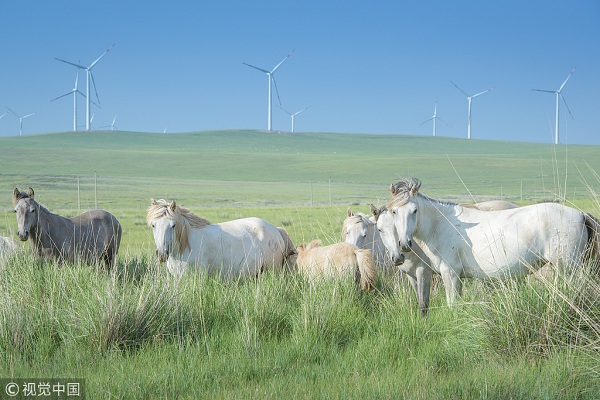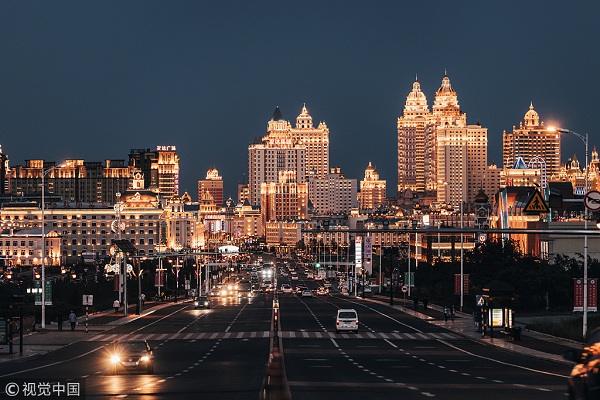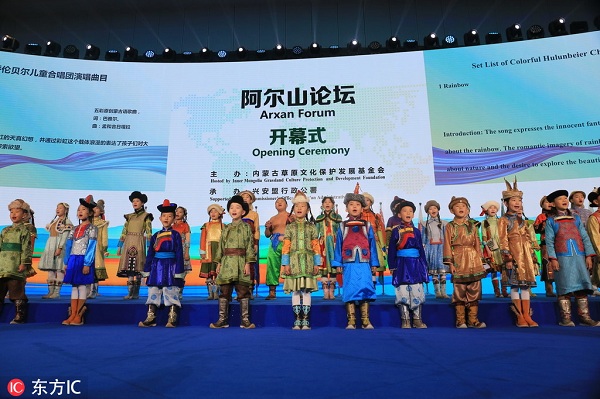Inner Mongolia expands opening-up for in-depth reform
Inner Mongolia autonomous region will focus on introducing high-end factors such as capital, technologies and talents, promoting competitive local firms and products in international markets, and expanding cross-border opening-up to develop the port economy, according to a meeting on regional economic development held in Hohhot, the capital of the autonomous region, in January 2019.

Mongolian horses in front of wind generators on the vast Xiliin Gol Grassland in North China’s Inner Mongolia autonomous region. [Photo/VCG]
New pattern of all-round opening-up takes shape
Opening-up is an engine that drives regional economic development and spurs modernization, and the location of Inner Mongolia decides its strategic significance in China's opening-up.
The region is adjacent to eight Chinese provinces (Heilongjiang, Jilin, Liaoning, Hebei, Shanxi, Shaanxi, Ningxia and Gansu) to the south and borders Russia and Mongolia to north. Dotted along its border of more than 4,200 kilometers, are 18 ports, including Manzhouli and Ereenhot.

A glittering night view of Manzhouli, a county-level city in Hulunbuir [Photo/VCG]
In 2018, Inner Mongolia achieved remarkable results in opening-up.
The import-export volume of foreign trade exceeded 100 billion yuan ($14.9 billion), a record increase of 9.9 percent year-on-year. The number of China-Europe freight trains departing from the region increased by 1.4 times and 2,853 China-Europe freight trains entered or left China through the ports of Manzhouli and Ereenhot, up by 34.2 percent year-on-year. These rail links safeguarded trade connections between countries involved in the Belt and Road Initiative (BRI).
An innovative mechanism for cooperation with Russia and Mongolia has taken shape. Five cities in Mongolia established sister city relationships with cities in the autonomous region. Moreover, economic and trade cooperation with Japan, South Korea, Hong Kong and Macao was deepened.
More than 1,700 local firms participated in the first China International Import Expo (CIIE), which took place in Shanghai from Nov 5 to 10, 2018, and yielded fruitful results. The impact of Inner Mongolian entrepreneurs has continuously increased as the first Arxan Forum and the second Inner Mongolia Entrepreneurs Convention were hailed as successes last year. Strategic cooperation was also reinforced with national ministries and departments and institutes, universities and firms in other provinces.

The first Arxan Forum with the theme of "global civilization dialogues and the community of human destiny" is held in Hinggan League, Inner Mongolia, Sept 16, 2018. [Photo/IC]
The Ordos Comprehensive Bonded Zone passed national inspection and review at the end of 2018. The zone has four main functions: bonded services, port operation, bonded logistics and bonded processing. It enjoys five major preferential policies, including tax relief, tax refunds and foreign-exchange management facilitation.
The achievements above confirmed the value of Inner Mongolia’s previous efforts in expanding opening-up and optimizing industrial structures. However, facing multiple opportunities and challenges in the new era, the region needs to recognize the fact of its low "foreign trade dependency" which also signifies vast development space for opening-up.
Foreign trade dependency, or the foreign trade index, is the ratio of import-export volume to GDP or GNP. It is an important indicator to measure the scale of opening-up to the outside, reflecting economic dependency on international markets.
Expanding scale and scope of opening-up
Inner Mongolia People's Government is determined to continuously expand its opening-up in 2019.
Its opening-up to the north will be expanded by speeding up the pace in constructing the China-Mongolia-Russia Economic Corridor and deepening cooperation with BRI countries.
The development of the port economy will be bolstered by fully leveraging the driving force of ports and international passages in the region, as well as comprehensive bonded zones, bonded logistic centers and foreign trade platforms in Hohhot, Baotou, Ordos and Chifeng.
The influence of local exhibition brands will be enhanced by actively taking part in the second CIIE and 2019 World Horticultural Exhibition in Beijing and successfully organizing the China-Mongolia Expo, the Arxan Forum and the Inner Mongolia International Energy Conference.
In addition, Inner Mongolia will also pay high attention to its interactive development with the national strategies of Beijing-Tianjin-Hebei Integration Development, Yangtze River Economic Belt construction, and Guangdong-Hong Kong-Macao Greater Bay Area construction.



 Print
Print Mail
Mail


